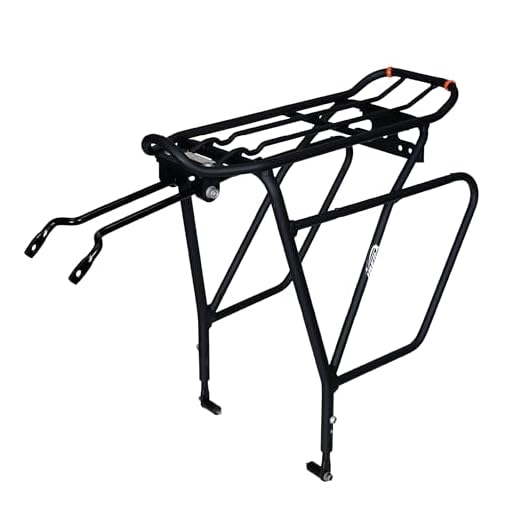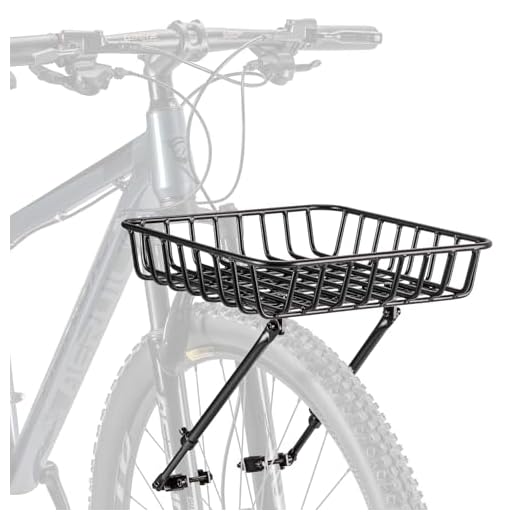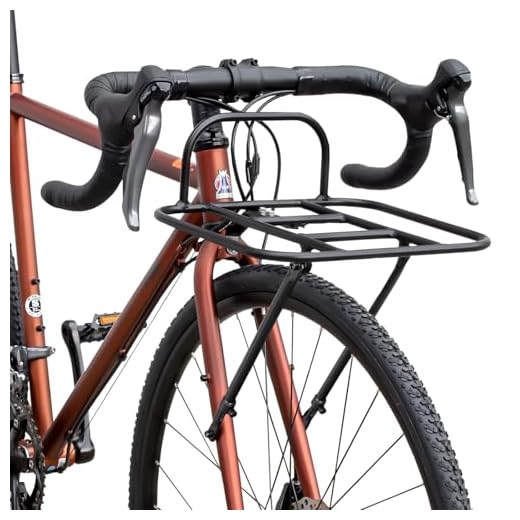






Secure the load firmly to the carrier to maintain stability. Use adjustable straps or bungee cords for various shapes and sizes, ensuring the contents won’t shift while in motion.
Before embarking, check the weight limit of the front mount. Overloading can compromise handling and safety. Distribute weight evenly on both sides to enhance balance, especially during sharp turns or sudden stops.
Adjust tire pressure based on the added weight. Slightly higher pressure can prevent pinch flats, while lower pressure may enhance grip on uneven surfaces. Test different pressures for optimal performance.
Be aware of your surroundings and anticipate how the added load affects your steering and braking. Practice maneuvering in a safe area before hitting busy streets. The extra weight alters dynamics, so maintain a wider turning radius.
For extended trips, consider using a weather-resistant cover for your cargo. This will protect against rain and wind, keeping your belongings dry and secure throughout your outing.
Strategies for Cycling with a Front Cargo Holder
Ensure a balanced load distribution to enhance stability and maneuverability. Place heavier items low and towards the center of the holder, while lighter items can be placed on top to avoid toppling.
Adjust your riding posture to accommodate the additional weight. Keep a relaxed grip on the handlebars and maintain an upright position to enhance visibility and control.
- Practice starts and stops in a safe area. Gentle starts help prevent tipping, and smooth stops can maintain equilibrium.
- Be mindful of turning angles. Wider turns can help avoid collisions with the cargo on the holder.
- Consider the impact on braking. Increased weight may require a longer stopping distance, so anticipate stops earlier than usual.
Regularly inspect the holder and secure items before each ride. Loose items can cause distractions or hazards while traveling.
For optimal organization, consider using accessories. Specialized containers like the best pails for umbrella racks can provide secure storage solutions while maintaining accessibility.
Experiment with different loads to find your ideal setup. Over time, skill and comfort will improve, allowing for a more enjoyable experience on each outing.
Choosing the Right Front Luggage Rack for Your Ride
Select a model that matches the type of cycling you plan to do. Consider lightweight options for commuting or robust ones for touring trips. Weight capacity is a key factor; check the manufacturer’s specifications to ensure it can support your gear.
Material and Build Quality
Opt for aluminum or steel constructions. Aluminum racks are lighter but may lack the durability of steel. Conversely, steel offers resilience but is heavier. Look for features like corrosion resistance and quality welds, which indicate a well-made product.
Attachment System
Verify compatibility with your frame design. Some use fork mounts while others clamp onto the frame. Quick-release mechanisms can simplify mounting and unmounting, enhancing convenience during trips. Ensure the chosen system is secure to avoid potential mishaps.
How to Properly Attach a Front Luggage Rack
Begin installation by selecting appropriate tools: a wrench, screwdriver, and any specific hardware provided by the manufacturer. Ensure the bicycle is positioned securely, preferably on a stand or upside down.
Next, identify attachment points on the frame and fork. Most models will have pre-drilled holes for mounting. Align the rack with these points, checking that it sits parallel to the ground for optimal stability.
For racks using clamps, place them around the fork. Tighten thoroughly but avoid over-tightening which could damage the forks. If using a rack that connects to the axle, ensure it sits snugly against the wheel with no obstruction to rotation or brake systems.
Once the main body is affixed, secure the supporting struts. At this stage, make sure they’re adjusted correctly to support weight loads without excessive flex. Struts connect to lower frame points and should be oriented correctly to prevent any interference with the wheel or components.
After tightening all connections, double-check alignment and stability. It’s wise to test-load the rack with lighter items before proceeding with heavier gear to ensure everything remains secure during transport.
| Step | Action | Notes |
|---|---|---|
| 1 | Select tools | Wrench and screwdriver |
| 2 | Identify points | Look for pre-drilled holes |
| 3 | Align rack | Ensure level positioning |
| 4 | Tighten clamps | Don’t over-tighten |
| 5 | Affix supporting struts | Adjust for load support |
| 6 | Test stability | Start with lighter items |
Best Practices for Loading Your Front Rack
Distribute weight evenly across the support to maintain stability. Avoid heavy items at the front to prevent diminished steering control. Place bulkier packages lower for better balance and stability.
Secure all loads with sturdy straps. Ensure nothing hangs loose, which could cause distractions or hazards. Check attachment points regularly to confirm everything is fastened correctly.
Utilize containers or bags designed for transport on carriers. They not only enhance organization but also protect belongings during transit. Opt for waterproof options if traveling in inclement weather conditions.
Keep reflective materials or lights visible on your load to improve visibility to others. This measure enhances safety during low light situations.
Avoid overloading limits set by the manufacturer. Refer to guidelines to prevent undue stress on the frame, which could lead to failures or damage. Regularly inspect your equipment for any signs of wear or fatigue after extensive use.
Test handling with a trial run before embarking on longer excursions. This practice allows for adjustments in packing strategy and identifies potential issues before the journey.
Adjusting Your Riding Technique with a Loaded Front Rack
Shift your weight slightly back to maintain balance. Distributing weight more towards the rear wheel helps stabilize the setup, especially when turning or encountering bumps. Keep the handlebars steady; avoid aggressive steering inputs to prevent wobbling. Position your hands firmly but relaxed on the grips for improved control.
Reduce your speed when navigating tight corners or uneven terrain. Carrying cargo alters handling, making swift maneuvers riskier. Anticipate turns earlier, leaning your body as needed, utilizing your core to adjust your balance.
Braking Strategy
Alter the braking technique. Use both front and rear brakes gently to avoid skidding, particularly with added weight. The front brake is more effective, but hard stops can lead to loss of control. Gradual pressure on the brake levers provides safer stops.
Situational Awareness
Increase alertness in traffic and crowded areas. The larger profile from the load can obscure your presence, prompting others to misjudge your distance or speed. Position yourself in the lane to enhance visibility and signal clearly when changing directions.
Safety Tips for Riding with a Front Luggage Rack
Ensure proper weight distribution. Keep heavier items low and centered to maintain stability.
Check attachment points regularly. Loose fittings can lead to unexpected shifts while maneuvering.
Avoid overloading. Stay within the manufacturer’s specified weight limit to prevent handling issues.
Adjust handlebars for easy control. A loaded rack can affect steering; ensure grips are comfortable and responsive.
Wear reflective gear. This increases visibility, especially with added bulk in front of you.
Use straps to secure items tightly. Prevent movement that might interfere with balance during your trip.
Practice turning techniques. Take wider arcs to accommodate the extra weight ahead, avoiding sharp pivots.
Be cautious on inclines. Extra front load can impact braking distance; allow more room to stop safely.
Maintain awareness of surroundings. External factors such as wind or obstacles require forethought with a weighted front.
Regularly inspect tires and brakes. Increased load calls for more frequent checks to ensure safe operation.
Maintenance Advice for Your Front Rack and Load
Regular inspection and care enhance the longevity of your cargo support structure. Begin by checking for signs of wear, rust, or bending. Ensure all bolts are tightened to prevent wobbling or detachment during use.
Cleaning Technique
Utilize mild soap and water for routine cleaning of the rack and connectors. A soft brush can help remove dirt without scratching the surface. For stubborn grime, consider products like this how to clean scalp scrubber for effective scrubbing.
Inspection Recommendations
- Check load limits regularly and do not exceed them.
- Inspect the attachment points to ensure they are secure.
- Look for signs of fatigue on the mounting brackets.
- Ensure reflective materials, if present, are clean and visible.
- Replace any worn or damaged components immediately.
Adhering to these guidelines prolongs the functionality and safety of your cargo attachment, ensuring a reliable transport experience. Regular maintenance guarantees peace of mind during your trips.
FAQ:
What are the advantages of using a front luggage rack on a bike?
Using a front luggage rack on a bike has several advantages. First, it provides a stable and accessible storage option, making it easier to carry items like groceries, camping gear, or work supplies. The distribution of weight is also beneficial, as it helps improve balance and control while riding. Additionally, having the load at the front allows for easier visibility of the items being carried, reducing the risk of accidents. Lastly, many front racks are compatible with various accessories such as baskets or panniers, enhancing versatility.
How do I properly install a front luggage rack on my bike?
Installing a front luggage rack involves a few key steps. First, ensure you have the appropriate rack for your bike’s frame type. Start by securing the rack to the fork legs using the provided mounting hardware. It may require a quick release or nut and bolt setup. Make sure to align the rack parallel to the ground before tightening the screws. Next, check that the rack is sturdy and does not obstruct the wheel or brake components. Once installed, you can attach your luggage or accessories. Always double-check the fitting before taking your bike for a ride.
Can I use a front luggage rack with any bicycle?
Not all bicycles are compatible with front luggage racks, but many standard models, such as road bikes, touring bikes, and mountain bikes, can be equipped. It’s crucial to check your bike’s fork design first; some models lack mounting points. If your bike does not have them, there are universal racks available that can be installed using clamps. It’s advisable to consult with a bike shop to ensure that your specific model can safely support a front rack.
What types of items are best suited for a front rack?
A front luggage rack is ideal for carrying lightweight items that need to be accessed easily while riding. Common choices include small backpacks, grocery bags, camping equipment, or even a child’s seat with a safety harness. It’s important to avoid overloading the rack, as this can lead to handling issues or damage to the bike. Keeping the weight balanced is key; heavier items can be placed lower on the rack, while lighter items can go on top.







